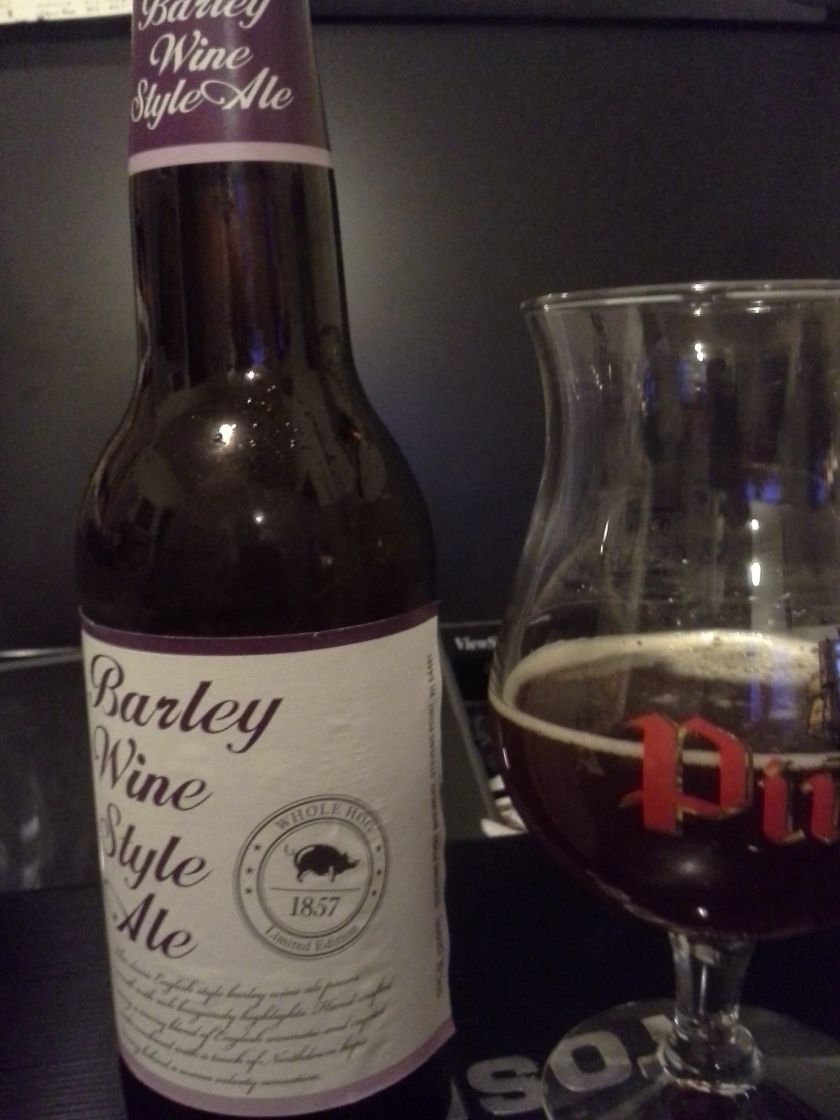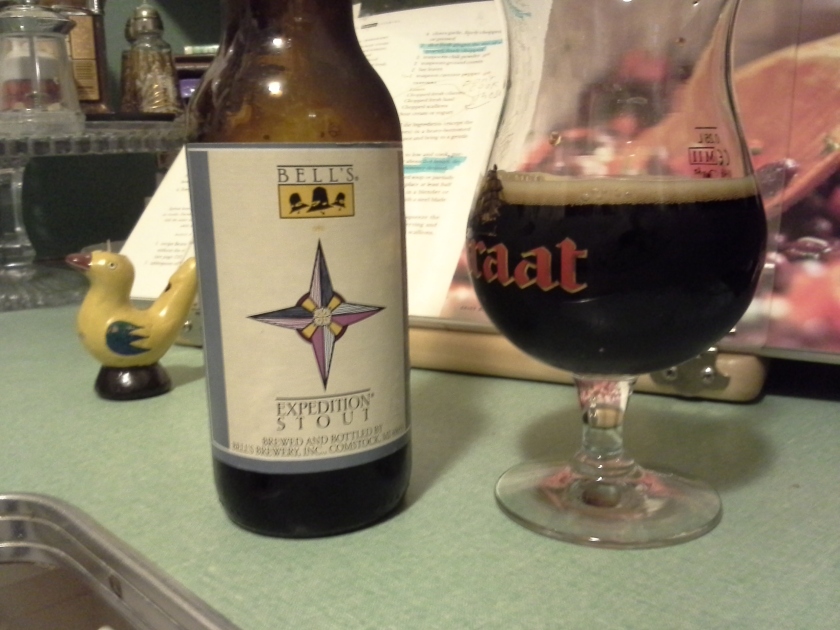
THREE FROM MY CELLAR
To Buy or Not to Buy?
1 = horrible
2 = bad
3 = average
3.5 = good (many better beers out there; won’t buy this again)
4 = very good
4.5 = great
5 = rare best
A Note on My Cellaring Experience:
Two things had me feeling anxious about all the beer in my cellar. First, my wife and I moved apartments last summer, and all the beer suffered a potentially bruising trip, jostled in the back of a moving van in hot weather. Second, the storage unit in the basement of our new apartment building didn’t stay cool summer long. In fact, for a period of at least a week or two, temps down there rose into the upper 70s if not lower 80s. Thankfully, I didn’t detect any ill effects in my test samples at the end of the summer, nor in any of these three beers, here.
Brewer’s Reserve Bourbon Barrel Stout, Central Waters Brewing Co.
Rating: 4.88/5
12 oz. bottle (4-pk) 9.5% abv, 70 IBU.
This is the “2012” from my cellar, 13 months of aging.
Pours nearly perfectly black, with a rim of tanned leather at the 2mm of fast-dissipating khaki foam, plus bits of lacing and legs of running alcohol on the glass.
In the nose it’s an umami cocoa, first and foremost. How choco-wonderous. Then aromas of toast, burnt sugar, and bourbon, with hints of coffee and vanilla. But one really has to work to get this complexity, as the aromas are whisper quiet. (In fact, I’ve demoted the aroma score.) The oak barrel is nice. People talk about toasted coconut in the aroma, but that’s one note I’ve been unable to fathom.
In the mouth it’s a spumoni ice-cream cross of vanilla and chocolate. It’s so good, one tends toward big mouthfuls to swish from side to side, front to back. It’s nearly the vanilla heights of Southern Tier Creme Brulee Stout. Perhaps it’s the aging, but the bourbon comes muted. (But my wife feels the bourbon is highly present.) Roasty malt and charred oak walk with maple syrup, burnt caramel, and chewy biscuit. Then the dried fruits come, some raisin or prune, and a candied cherry. The merest suggestions of pine-hops and anise twist the thumbscrews of complexity. It all washes down with coffee and cream on the backend.
Medium- to full-bodied, fabulously smooth, with a modest carbonation and a mild boozy heat.
Decadent, delicious. It goes down fast. Something this rich, you would expect it to be a one-and-done type of deal. But I feel I could have several. Perhaps that’s the beauty of a sub-10% abv.
I’m just as impressed with this as I am BCBS or Mikkeler Black Hole or Midnight Sun Berserker. It puts into perspective Tier 1 vs. Tier 2 imperial stouts. Now relegated to Tier 2 are: Stone Imperial Russian Stout, Founders Breakfast Stout, Southern Tier Mokah/Jahva, Weyerbacher Tiny, and Goose Island Big John.
Brewers Reserve Bourbon Barrel Barleywine Ale, Central Waters Brewing Co.
Rating: 5/5
12 oz. bottle (4-pk) 11.2% abv, — IBU.
This is a “2013”, so eleven months of aging.
A clear reddish-caramel in a tulip glass, with almost no head, even after an moderately aggressive pour (hence the 11.5% alcohol). Lacing is sparse, but with serious stick-to-it-iveness and dripping legs down the glass.
How I miss this aroma. Brings me right back to snowy April of last year. Bourbon in the nose seems nicely muted compared to my memory of it. I remember the bourbon being more pronounced in the aroma. The vanilla, too. Oak and char and melted butter bring further bouts of nostalgia. Brown sugar and raisin, too. Yeah, baby.
In the mouth the aging is instantly evident, with the hop bitterness knocked way back (though there’s still a ghostly, earthy pine bitterness on the back-end, for sure). Pushing against the simple-syrup sweetness, the quiet hops present about an 80 or so IBU. The flavor is wonderfully round: soft sugar cookie, ice-cream-caramel swirl, fig and prune, then the bourbon. I put more in the glass, and pie crust fills my nostrils. Plus Juicy Fruit Gum and marshmallow. It’s massively toffee sweet, and yet the mild hops and tannins from the oak–not to mention the brightness of the still-respectable boozey ABV–bring balance. It drinks like Dogfish Head 120 Minute.
Despite a fairly significant carbonation, the smoothness makes me want to cry. It gives the feel of a super-syrupy moscato di asti. Definitely more an English Barleywine profile, at least after the aging. How astonishing to experience true beer nirvana. I feel like I did two years ago sipping a JW Lees Harvest Ale for the first time.
CW’s detractors denounce them as a one-trick (bourbon barrel) pony. Not only is this wrong (duh, Illumination? Exodus? La Petite Mort?). But even if true, this is bourbon-barrel aging at its very best.
Bourbon County Brand Stout, Goose Island Beer Co.
Rating: 5/5
12 oz. bottle (4-pk) 15% abv, — IBU.
This is a 2012 BCBS, so 18 months-old. It’s much smoother, sweeter, with less astringency than it had last year. There’s still almost no head to speak of, poured into a snifter. It looks like soy sauce with some floating bubbles. I might have said it also smelled of soy sauce, or at least chilled soy sauce. Then I realized the aroma was tart plum, fruitcake, and moist spice cake. Wow. What eye-popping clarity in this complexity. I’m beside myself (even if my less craft-beer-minded guests are non-plussed) with how amazing an aged BCBS is. The most astonishing surprise here is a distinct peppermint stick aroma.
Can you say “Port Wine”? My wife just asked me what I would think if tasting this without knowing anything of its provenance or vintage. I tried to imagine it, and I think, yep, port wine. Charred nuts, dried fig, and burnt raisins make for a thematic, seasonal flavor–it’s that fruitcake flavor from the aroma. The bitterness resembles molasses more than it does hops. Balance comes from the spicy alcohol.
Creamy and thick on the palate.
I can only say thank God I’ve got four more 4-packs in the cellar. This is the shiznet, by all standards.




